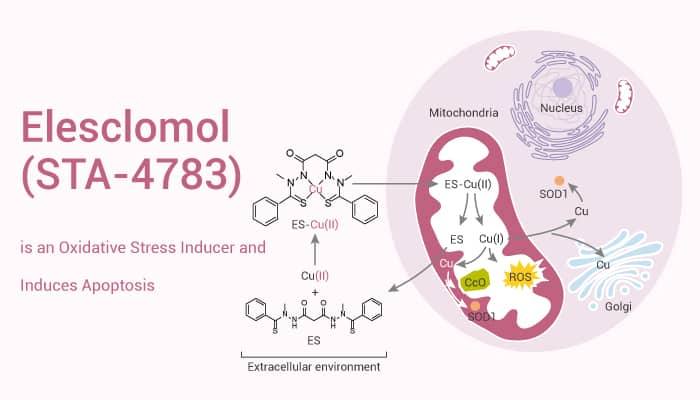Modulating reactive oxygen species (ROS) levels has been proposed as a therapeutic strategy for cancer. In normal cells, ROS are produced at low concentrations and cancer cells produce elevated levels of ROS due to increased metabolic activity, resulting in a state of chronic oxidative stress. Recent studies showed the utility of agents that increase cellular ROS levels to effectively kill cancer cells. Indeed, oncogenic transformation results in abnormal increases in ROS that render cancer cells sensitive to oxidative stress inducers. These inducers further elevate ROS levels beyond a threshold, ultimately triggering apoptosis. In contrast, normal cells are less sensitive to agents that induce oxidative stress due to their low level of ROS production and high antioxidant capacity.
It is reported that Elesclomol is an oxidative stress inducer that induces cancer cell apoptosis. Elesclomol is a reactive oxygen species (ROS) inducer. Elesclomol shows antitumor activity against a broad range of cancer cell types. Moreover, Elesclomol is also a highly lipophilic Cu<sup>2+</sup>-binding molecule.
In vitro, Elesclomol (200 nM; 18 hours) treatment increases the number of early and late apoptotic HSB2 cells. Especially, Elesclomol induces apoptosis in cancer cells through the induction of oxidative stress. Additionally, Elesclomol significantly inhibits the cell viability of SK-MEL-5, MCF-7, and HL-60 cells with IC50 values of 110 nM, 24 nM and 9 nM, respectively.

In vivo, Elesclomol (10 mg/kg; subcutaneous injection) treatment ameliorates severe cardiac pathology with a partial reduction in hypertrophy. Cardiac [Cu] increased with Elesclomol treatment from a vehicle knockout level of 34 to 55%. What’s more, Elesclomol escorted copper to the mitochondria and increased cytochrome c oxidase levels in the brain.
To sum up, Elesclomoln is a potential anti-cancer agent with diverse activities, and the compound is now in clinical studies.
References:
[1]. Science. 2020 May 8;368(6491):620-625.
[2]. Mol Cancer Ther. 2008 Aug;7(8):2319-27.